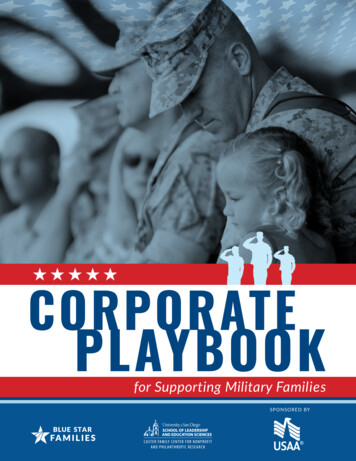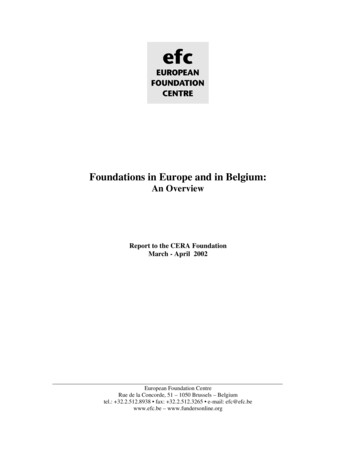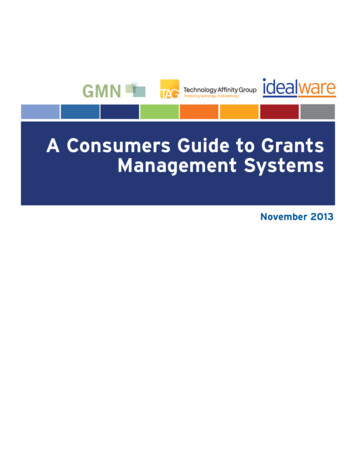
Transcription
for Supporting Military FamiliesS P O N S O R E D BY 1
“Military families live in our neighborhoods. Their childrengo to our schools. Much can be learned from them.Building and sustaining healthy, resilient, and thrivingmilitary children and families will bring benefits not justto them but ultimately to all Americans. The militaryfamily is the American family.”Supporting military families is vital to sustaining the All-Volunteer Force and astrong national defense. Service members and their families will continue tobe asked to do more with less. Military families are central to service memberrecruitment and retention decisions, and to overall military readiness.F O R M O R E I N F O R M AT I O NAmerican Psychologist, Military children and families: Strengths and challenges during peace and war.Blue Star Families, 2015 annual Military Family Lifestyle Survey 3
America’s active duty, guard, and reserve military men and women and their families havemade many sacrifices in service to our country, and now it is our turn to give back.YOU WILLLEARN ABOUT: The unique strengths andchallenges of militaryfamilies Best practices forsupporting military families Why your company shouldsupport military families The steps to begin, orstrengthen, your company’splan to support militaryfamilies4INTRODUCTIONAmerica's veterans have received a great deal of attention and supportfrom corporations, the government, and grant makers over the pastseveral years. Though this is commendable, support for our currentlyserving military families (defined as an Active Duty, National Guard,or Reserve service member, their spouse, and/or their children as oneunit), is critically needed.Our country's military men and women do more than protect againstan enemy abroad. For example, they protect trade routes, underwaterdata cables, and satellites in space so that global markets, naturalresources, and advanced global communication systems remainavailable to U.S. business and industry. The families who supportthem do so proudly, but at a cost their civilian peers do not have tobear. For this reason, they are central to a service members’ decisionto join or to stay in the military. Thus, the military family unit, as awhole, is vital to the overall strength of our All-Volunteer Force.“USAA was founded BY themilitary community FORthe military community.In alignment with our legacy,heritage, mission and brand,we have an enduringcommitment to support themilitary community.”- USAAAs sources decline and demand increases, military families willcontinue to be asked to do more with less. New or additionalresources and funding are needed in order for military families tosustain a healthy lifestyle. When a company invests in military familiesit invests in the security and strength of our nation! Department of Defense, Demographics ReportsF O R M O R E I N F O R M AT I O NMilitary OneSource, Various Reports and Surveys 4
TALENTACQUISITIONEMPLOYEERETENTION WHY SUPPORTMILITARY FAMILIES?Business success is dependent ona company’s reputation and itsrelationships with its employees,customers, vendors, partners,and community. According toCone Communications, supportof military issues is one of theTop 3 “Most Compelling Causes.”Their research found that 66%of corporate executives thoughttheir social responsibility strategiesresulted in improving theircompanies’ reputations.Supporting military families isnot just the right thing to do –it is also the smart thing to do.Hiring and supporting militaryfamilies will result in better relationswith the military community as wellas the broader community.“Our nation’s military servicemembers, veterans, and theirfamilies sacrifice so much toprotect us and ensure our freedom.We must provide our time,talent, and treasure to honorand support them.”- USAASTRENGTHENLOCALECONOMYTAL E NT ACQ UISITION80%of people want to workfor a company that caresabout societyThe core skills that service members learn:“camaraderie, teamwork, leadership,reliance on each other, and loyalty.”- MicrosoftCOMMUNITYRELATIONSCUSTOMERLOYALTYCOM M UNITY RE L AT I ON S92%of Americans have amore positive imageof a company alignedwith a cause“There is a lot of goodwill in this countryfor military Military families are animportant part of our community andintegral to our national security.”- Booz Allen HamiltonCUSTOM E R LOYALTYMilitary affinity audiencealone is 100 millionAmericans with nearly 1 trillion spending powerSTRE NGTHE NLOCAL ECO NOM Y 1 billion per year is thesocial cost of under/unemployed militaryspouses in the US91%of consumers wouldswitch brands if the otherbrand were associatedwith a good causeE M PLOYE E RE T E N T I ON60%of employees whoare proud of theircompany’s socialresponsibility are moreengaged in their jobsF O R M O R E I N F O R M AT I O NMilitary OneSource, Various Reports and SurveysDepartment of Defense, Demographics ReportsCone Communications, Research 5
SNAPSHOT OF THE MILITARY COMMUNITY2015AC T I V E D U TY1,301,443selected reserve force members(about 1% of total US population)201,413men (85%)AV E RAG EAG E:669,146women (15%)35 yearsOfficers54% aremarriedmen (81%)S E RV I C EMEMBERS27 yearsEnlistedAV ER AGEAGE:active dutymilitary spouses*M A R R I AG E1,087,071 active duty military dependent children42% 0 to 5 years32% 6 to 11 years22% 12 to 18 years5% 19 years41%CHILDRENof DoD militarypersonnel have childrenEN L ISTE D:selectedreserve spouses*87% have a bachelor’s degree or higherE DUC ATI ON11% have a bachelor’s degree or higher87% have a high school diploma and/orsome college experienceF O R M O R E I N F O R M AT I O NBlue Star Families, 2016 annual Military Family Lifestyle SurveyDepartment of Defense, Annual Report to Congress on Plans for the Support of Military Family ReadinessThe Future of Children, Military Children and Families (2013)Military OneSource, Various Reports and Surveys374,62142%* Dual serving couples are counted twice 30 yearsEnlistedof selected reservepersonnel have childrenENLI ST ED:84% have a bachelor’s degree or higher639 yearsOfficers689,604 selected reserve children0 to 5 years 31%6 to 11 years 31%12 to 18 years 28%19 years 11%OFFICERS :some college experiencewomen (19%)3% dual-military marriages*O FFI CERS :8% have a bachelor’s degree or higher92% have a high school diploma and/or156,96045% aremarried641,6396% dual-military marriages*Guard and Reserves826,106active duty members1,100,030SEL ECTED RESERV E FORCE
MILITARY FAMILY LIFESTYLEANNUAL SURVEY RESULTS72%42%feel current operations tempo exerts unacceptablelevel of stress for a health work-life balancereported experiencing 6 months of separationin the last 18 monthsMILITARY FAMILIES ARE nunemployment60% ACTIVELY SEEKING WORK63%MODERATE TO SEVERE DEPRESSION88%of active duty family respondents felt the general publicdoes not truly understand the challenges or sacrificesmade by service members and their familiesof currently serving military service members and theirspouse/partner experience anxiety or depression73% 65%of military familiesof veteransVOLUNTEERED IN THE PAST YEAR66%of military families indicated they are not always able tofind the childcare they need, largely due to accessibilityand affordability challengesF O R M O R E I N F O R M AT I O NBlue Star Families, 2016 annual Military Family Lifestyle Survey 7
THE LIFE CYCLE OF MILITARY FAMILIES:1. Early integrationinto military culture and life2. Permanent Changeof Station (PCS)The military lifestyle has its ownculture, norms, and expectations.Adapting to this culture can be difficultand confusing at first.A PCS occurs when a militarymember receives new orders whichresult in a geographic move forthe family.On average, military families moveevery two to three years.3. Deployment of themilitary member4. Transition from activeduty to civilian lifeDeployment is when the servicemember is sent on temporary orders toengage in military operations in anotherlocation that causes separation fromtheir family.As the reduction in force sizeNever ending war and conflict acrossthe globe means that families are facingcontinuous and frequent separations.continues, more military families willbe transitioning from active duty tocivilian life. This transition mayinclude relocating the family, newcareers for service members andspouses, as well as findingsupportive services that the militaryis no longer providing.“Government and public funding is not enough to take care of our military families.We all, especially businesses, need to do our part.”F O R M O R E I N F O R M AT I O N8 Council on Foundations, Supporting Veterans & Military FamiliesBooz Allen Hamilton & Blue Star Families, Corporate Employee Engagement Summit (2015)- USAA
MILITARY FAMILIES:STRENGTHS, CHALLENGES, &OPPORTUNITIES“The initial urge is to help veterans. If corporations supported military families,they could make a larger impact.”- Booz Allen HamiltonFamilies who servehave unique challengesbecause of the lifeEducationcycle experiencedby military families.However, they doreflect the needs ofmost civilian familiesEmploymentas well. Therefore,the opportunities tostrengthen militaryfamilies will alignwith your company'sBasic Needs &Financial Readinesscommitment tocommunity-basedpriorities.Health & Wellness 9
EDUCATIONAt every stage of the lifecycle, military families have educationchallenges. Often, education is interrupted for the military family dueto deployment cycles, multiple moves, and the eventual transitionperiod into civilian life.“When the military child is doing well, it’s a huge relief and one less thing to worry aboutwhen on deployment overseas, where focus is critical for the service member.” - MicrosoftSTRENGTHS & CHALLENGESOPPORTUNITIESMilitary families can benefit from corporate support by: Military children, on average,attend six to nine different schoolsystems. Different school districtsand states have varying curriculaand requirements, which may createroadblocks for transitioning militaryfamilies and their childrenFor families withchildren who havespecial needs, multiplemoves can add stressProviding post-secondary education scholarships for all membersof military families Supporting quality, affordable and flexible childcare Sponsoring after-school programs for military children and youth Volunteering as mentors, tutors, and coaches Funding workforce development training programs that haveflexible schedules and online opportunities Providing trainings that will help existing community programsbetter serve military connected families Advocating that the Interstate Compact on EducationalOpportunity for Military Children is being implemented in yourlocal communityfinding the properresources and supportin a new communityIn addition, transitioning families"Moving frequently may impact [my son's] ability to learn on an effective,consistent timline, as well as form and retain social relationships."- Army spousewho have special needs familymembers need to find new servicessince they will no longer be eligiblefor the military’s ExceptionalFamily Member Program, a serviceF O R M O R E I N F O R M AT I O Navailable to active duty familiesBlue Star Families, 2016 annual Military Family Lifestyle SurveyThe Future of Children, Military Children and Families (2013)10 Military Child Education Coalition, The Interstate Compact on Educational Opportunity for MilitaryChildren
EMPLOYMENTOf the military families who participated in the Blue Star Families2016 annual Military Lifestyle Survey (2016 BSF aMFLS), 51%identified spouse under/unemployment as a top obstacle tofinancial security. Throughout the military family lifecycle, becauseof the frequent moves and deployment, employment is a bigchallenge for many military spouses (90% of which are female).“The best thing you can give a military service member is a job for their spouse.”- Blue Star FamiliesOPPORTUNITIESIn addition to hiring military spouses and military youth, some ofthe ways that the business sector can help support military familymembers becoming gainfully employed include: Offering career counseling Expanding career services Supporting programs that provide skill and employment trainings Offering scholarships for post-secondary education, includingcertification trainingsSupporting quality, affordable and flexible childcareOffering flexible schedules and telecommuting options foremployees who are military spousesCreating military family-friendly policiesAdvocating for reciprocity across states for professionalcertification or degree licensure“As part of our program, select Starbucks partners will help militaryspouses build their resumes and hone interview skills. They will also invitespouses in for coffee and conversation and host game nights for families.”- StarbucksF O R M O R E I N F O R M AT I O NBlue Star Families, 2016 annual Military Family Lifestyle SurveyDepartment of Defense, Military Spouse Employment PartnershipInstitute for Veterans and Military Families at Syracuse University, The Force Behind the Force: Training,Leveraging, and Communicating about Military Spouse as EmployeesSorenson Impact Center, University of Utah, The Social Cost Analysis of the Unemployment andUnderemployment of Military SpousesSTRENGTHS & CHALLENGESAccording to the Sorenson ImpactCenter, military spouses are:UNDER-REPRESENTEDIN LABOR FORCE:M I L I TARY SP OU SE S57%CIVILIAN ouses are six times morelikely to earn salaries below their L E S Seducation and experience levelU N E M P L OY M E N T R AT E :M I L I TARY SP OUSE S18%N AT I O NA LVS4%W E L L E D U C AT E D :Over 25% have atleast a bachelor’s degreeand military spousesoutperform the generalfemale populationfor graduate andprofessional degreesMost importantly,military spouses want to work.Blue Star Families found that 60%of active duty, guard, and reservespouses who were not workingindicated they want to be employed 1111
BASIC NEEDS &FINANCIAL READINESSMany military families face major financial strains whichnecessitate the need for help with financial stability and housingduring their active duty years and/or the transition process.“Don’t be afraid to go after the hard issues. Financial stability is a tough challenge for military families.Thus, funding programs that promote upward mobility can have a big impact.” - Booz Allen HamiltonSTRENGTHS & CHALLENGESFrequent moves/PCS costs toppedthe list of unanticipated expensesfor currently serving militaryfamilies, with 56% of respondentsfrom the 2016 BSF aMFLS statingthey had incurred unexpectedrelocation expenses65% to 70%of service membersdo not live ingovernmenthousingService membersare taking onmore debt thanin the pastFood pantries operate on ornear every Navy and MarineCorps base to address thefood insecurity issues of somemilitary families12 OPPORTUNITIESIn addition to supporting employment and educationopportunities, companies can help military families avoid financialdistress by: Providing financial readiness workshops and counseling Funding programs and efforts that support military connecting tothe local community Supporting affordable housing for military families, especiallythose transitioning to civilian life Assure that nonprofits providing basic needs are also servingmilitary families Advocating for increase in government financial supports formilitary families“We believe that honoring our veterans and military spouses requiresmore than saying ‘thank you.’ It’s about providing opportunities forveterans and their families. These men and women are making ourcompany better.”- StarbucksF O R M O R E I N F O R M AT I O NBlue Star Families, 2016 annual Military Family Lifestyle SurveyThe Future of Children, Military Children and Families (2013)Military OneSource, Status of Forces Survey of Active Duty Members (2013 & 2014)
HEALTH & WELLNESSFrequent moves and deployments can take military familiesaway from their close networks of family and friends. Thissense of isolation can lead to an increase in stress levels anddepression for military spouses and their children.“The spouse is often left with the harder job of managing the home front. They need to carry on with thedaily grind, while the service member has their mission to focus their time and energy on.”- MetLifeSTRENGTHS & CHALLENGESOPPORTUNITIESThe business sector can strengthen military families by: Convening nonprofit, academic, military, civic, and businessleaders in the community to address the unique needs ofmilitary families Sponsoring social events and opportunities that connect militaryfamilies to each other and the larger community Funding mental health programs for military families that offerconfidentiality by being close to military installations Providing caregivers of wounded and injured service members orchildren with special needs opportunities for self-care Advocating for better health and wellness programs for servicemembers and their families who voluntarily separate or retire“We do this work to help the transitioning service member as well astheir spouse and children. This is vital to the well-being and overallsuccess of the service member.”- MicrosoftF O R M O R E I N F O R M AT I O NBlue Star Families, 2016 annual Military Family Lifestyle SurveyBoys & Girls Clubs of America, Great Think: Creating Great Future for Military Families & YouthThe Future of Children, Military Children and Families (2013)National Endowment for the Arts & Blue Star Families, Blue Star MuseumsNational Military Family Association, Health CareRand Corporation, Military Caregivers Study; Military Health and Health CareRosalynn Carter Institute for Caregivers, Caregiver ResourcesPoints of Light, Community Blue PrintAccording to the 2016 BSFaMFLS Survey:88%of respondents feel the generalpublic does not understandsacrifices made by servicemembers and their families40%of active duty, guard, and reserverespondents feel that seeking mentalhealthcare will harm their careerNearly 20% ofcurrently servingmilitary servicemembers and militaryspouses admittedthoughts of suicide inthe past year1.1 million Post 9/11military caregiversMilitary caregivers experiencemore health problems, face greaterstrains in family relationships, andhave more workplace issues thannon-caregivers. Caregivers are mostcommonly the spouse:· 63% employed· 47% have a support network· 37% age 30 or younger· 32% have no health insurance 13
“Leadership needs to be brought in to make it part of the culture.”– Starbucks What assets does your company have that can be sharedwith, or help, military families? HOW YOUR COMPANYCAN SUPPORTMILITARY FAMILIESINTERNAL ASSESSMENTThere are many ways forcorporations to engage insupporting military families.The best fit for your companyis to find the organization(s)or cause(s) that bestaligns with your corporatepriorities, culture, and values.Taking the time to explorethe options will yield a morefavorable outcome for allinvolved. By asking thefollowing questions, you willset your company up for asuccessful support initiative. CashMatching financial contributionsIn-kind product donationsProfessional expertiseStaff volunteer hoursWho will be the champion for your military family efforts?“Programs and initiatives such as these need executiveleadership in order to motivate and encourage employeeparticipation and volunteerism. We are lucky to have thislevel of leadership and commitment from the ExecutiveSponsor of our grassroots employee engagement group, theVeterans Community Network, which champions all of ourveteran and military family efforts.”- Bristol-Myers Squibb Foundation What connections does your your leadership and staff haveinternally that can help your company identify the needs oflocal military families? How engaged does your company want to be withmilitary families? Short-term supportEvents are an example of short-term support. Long-term support or short-term supportLong-term support involves continual engagement on specific projects that benefit military families and provide engagementfor your company.What kind of relationship works best for your company? Don’t fund just because it’s popular“Make sure it’s a good fit.” - Uber Are there current partnerships that your company hasor organizations that you support who could alsoengage with you to support military families?“Our work with military really resonates with our employees. We were able to connect theirdesire to do something to help military families in tangible ways.”-Bristol-Myers Squibb Foundation14
Identify which issue(s) makes the most sense for your company Talk with internal leadership and staffDetermine if employees are connected to military issues or know of militaryfamily organizations in the community Ask local community leaders and organizationsUnited Way, regional associations of grantmakers, community foundations,and local military base leaders are excellent starting pointsCHECKLIST FORSUCCESSFULCORPORATEGRANTMAKINGEFFORTS Ask other companies who are doing the work nationally Assess if the issue(s) make sense for your company Does it meet business priorities and objectives? Does it resonate with your employees? Does it match your giving or marketing priorities? Develop an internal-strategy to engage your company Facilitate groups of employees, vendors, shareholders andnetworks to work together“In order to succeed withsupporting the militarycommunity, survey the areayour company is located,determine the impact you Discuss potential incentives for employee engagement andvolunteerism.want to have and search for Decide the most appropriate type of support or communitygeography and goals.”investment that fits with the issue(s) selectedpartners who align to your- MetLife Financial contribution to nonprofits supporting military families Employee volunteers Sharing of professional skills or experience In-kind product donation Define your marketing and communications strategy How will your support be communicated internally as well asexternally to the broader community? Identify potential collaborative partners“By partnering with theChamber of Commerce, wehave been able to connect Find a suitable nonprofit or organization to partner withwith military families on base.” Do your due diligence; research organizations to ensure they- Ubermeet their missions before investing via Charity Navigator,Guidestar, or Council on Foundations“Engage with the folks who know the community.” – San Diego Gas & Electric 15
ACKNOWLEDGEMENTSThe Corporate Playbook for Supporting Military Families is made possible thanks to the generous sponsorship ofUSAA. Blue Star Families collaborated with the University of San Diego’s Caster Family Center for Nonprofit andPhilanthropic Research to create the content.The U.S. military deploys an all-volunteerforce worldwide to protect our nation. Ourmilitary service members and their familieswillingly make significant sacrifices to keepus all safe. They're extremely proud to serveall Americans, despite the added challenges.In April of 2009, a group of military spousescreated Blue Star Families: an organizationconnecting military families with communityneighbors to ease the challenges ofmilitary life and provide a simple way for allAmericans to help keep our military strong.Blue Star Families' groundbreaking researchhelps us innovate solutions to the mostpressing problems of military family life.Our programs reach more than 1.5 millionmilitary families annually, providing careerdevelopment, caregiver support, educationalprogramming and supportive communityconnections.Housed within the Nonprofit andPhilanthropic Institute at the School ofLeadership and Education Sciences (SOLES)at the University of San Diego, the missionof the Caster Center is to provide research,evaluation, and consulting services thatbuild the leadership and strategic- andevaluative-thinking capacity of nonprofits.The Caster Center strives to be the leadingsource of information, data, and research onthe nonprofit sector. It offers resources andproducts that are grounded in systematicresearch and have direct applicability tothe field. It also serves as an importanttraining facility that enables doctoralstudents to directly engage in innovativeand timely nonprofit research projects. TheCaster Center works in collaboration, andunder contract, with nonprofit service andcharitable organizations on a wide rangeof projects.Blue Star Families ensures that whereverAmerican military families go, they canalways feel connected, supported andempowered to thrive – in every communityand around the globe.Blue Star FamiliesPO Box 230637Encinitas, CA 920231-844-202-STARbluestarfam.org16 The USAA family of companies providesinsurance, banking, investments, retirementproducts and advice to 11.8 million activeand former members of the U.S military andtheir families. USAA membership is opento all who are serving our nation in the U.S.military or have received a discharge typeof Honorable – and their eligible familymembers.Founded in 1922 by 25 Army officers inSan Antonio to fill the military community’sneeds for automobile insurance, USAAis proud to carry on the legacy of itsfounders by addressing needs in the militarycommunity and its local communitiesthrough its corporate responsibility program.USAA employs strategic focus areas toprioritize its philanthropic investmentsin support of military family resiliencynationwide and improve the quality of livingin the communities where USAA has aphysical location and significant employeepresence. For more information aboutUSAA’s corporate responsibility program,visit usaa.com/corporateresponsibility.Thank you to the following for sharing theirknowledge and experience:AT&T MicrosoftBooze Allen Hamilton San Diego Gas & ElectricBrystol-Myers Squibb Foundation San Diego GrantmakersCouncil on Foundations StarbucksMetLife UberUSAAPHOTOS BY:Master Sgt. Carl Clegg, LanceCpl. Zachary Ford, Seaman AlanaLangdon, Kristen Wong, and PettyOfficer 2nd Class Daniel Young 16
MARRIAGE 27 years Enlisted 35 years Officers FOR MORE INFORMATION Blue Star Families, 2016 annual Military Family Lifestyle Survey Department of Defense, Annual Report to Congress on Plans for the Support of Military Family Readiness The Future of Children, Military Children and Families (2013) Military OneSource, Various Reports and Surveys






